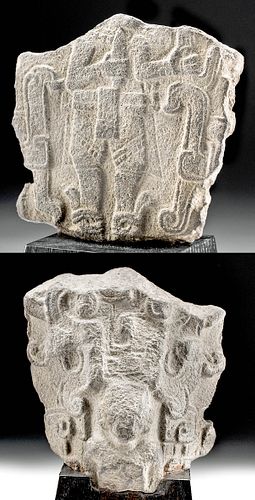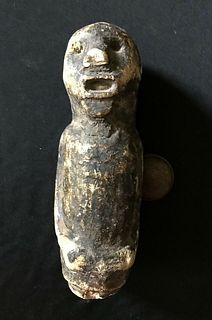Aztec Stone Palma Fragment w/ Sacrificial Scene
Lot 107
About Seller
Artemis Gallery
686 S Taylor Ave, Ste 106
Louisville, CO 80027
United States
Selling antiquities, ancient and ethnographic art online since 1993, Artemis Gallery specializes in Classical Antiquities (Egyptian, Greek, Roman, Near Eastern), Asian, Pre-Columbian, African / Tribal / Oceanographic art. Our extensive inventory includes pottery, stone, metal, wood, glass and textil...Read more
Estimate:
$2,400 - $3,600
Absentee vs Live bid
Two ways to bid:
- Leave a max absentee bid and the platform will bid on your behalf up to your maximum bid during the live auction.
- Bid live during the auction and your bids will be submitted real-time to the auctioneer.
Bid Increments
| Price | Bid Increment |
|---|---|
| $0 | $25 |
| $300 | $50 |
| $1,000 | $100 |
| $2,000 | $250 |
| $5,000 | $500 |
| $10,000 | $1,000 |
| $20,000 | $2,500 |
| $50,000 | $5,000 |
| $100,000 | $10,000 |
| $200,000 | $20,000 |
About Auction
By Artemis Gallery
Apr 8, 2021
Set Reminder
2021-04-08 10:00:00
2021-04-08 10:00:00
America/New_York
Bidsquare
Bidsquare : Fine Antiquities | Asian | Ethnographic Art
https://www.bidsquare.com/auctions/artemis-gallery/fine-antiquities-asian-ethnographic-art-6770
Features classical antiquities, ancient and ethnographic art from cultures encompassing the globe. Egyptian, Greek, Roman, Etruscan, Near Eastern, Asian, Pre-Columbian, Native American, African / Tribal, Oceanic, Spanish Colonial, Russian, Fine Art, so much more! All legally acquired, legal to sell. Artemis Gallery info@artemisgallery.com
Features classical antiquities, ancient and ethnographic art from cultures encompassing the globe. Egyptian, Greek, Roman, Etruscan, Near Eastern, Asian, Pre-Columbian, Native American, African / Tribal, Oceanic, Spanish Colonial, Russian, Fine Art, so much more! All legally acquired, legal to sell. Artemis Gallery info@artemisgallery.com
- Lot Description
Pre-Columbian, Valley of Mexico, Aztec culture, ca. 15th to 16th century CE. An exemplary carved-stone fragment from an Aztec ballgame palma displaying two skillfully sculpted scenes, a convex frontal face, and a flat verso. The convex face depicts the head and torso of a figure surrounded by a swirling, maze-like background. Alternatively, the verso is carved with the shoulders, torso, and legs of a priest dressed in a loin cloth and holding a flint knife used to cut out the hearts of human sacrifices, a reference to the fate of the losing team at the ballgame. Named for their palm-frond-like shape, stone palmas were ceremonially made sculptural versions of the lightweight protective gear worn by players during the ballgame. Size: 5.5" W x 5.5" H (14 cm x 14 cm); 10.5" H (26.7 cm) on included custom stand.
According to Patricia Joan Sarro of the Metropolitan Museum of Art, "Palmas, named for their palm frond shape, were one element of the elaborate regalia worn by Mesoamerican ballplayers. Resting atop the yoke worn around the player’s hips, they extended up the middle of the ballplayer's chest to protect major organs from the impact of the hard rubber ball used in the game."
Provenance: private Hawaii, USA collection; ex-private T. Misenhimer collection, Beverly Hills, California, USA, collected from 1970 to 2008
All items legal to buy/sell under U.S. Statute covering cultural patrimony Code 2600, CHAPTER 14, and are guaranteed to be as described or your money back.
A Certificate of Authenticity will accompany all winning bids.
We ship worldwide and handle all shipping in-house for your convenience.
#161447Collection label on base. Fragment of a larger piece. Expected surface wear as shown with light softening of detail commensurate with age. Otherwise, excellent with lovely earthen deposits throughout.Condition
- Shipping Info
-
All shipping is handled in-house for your convenience. Your invoice from Artemis Gallery will include shipping calculation instructions. If in doubt, please inquire BEFORE bidding for estimated shipping costs for individual items.
-
- Buyer's Premium



 EUR
EUR CAD
CAD AUD
AUD GBP
GBP MXN
MXN HKD
HKD CNY
CNY MYR
MYR SEK
SEK SGD
SGD CHF
CHF THB
THB















